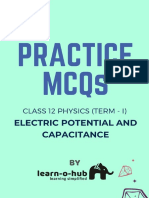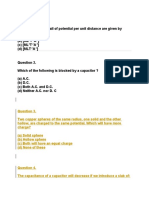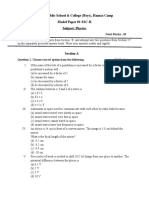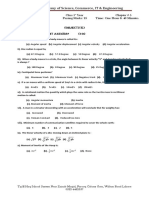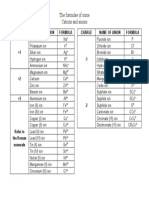0 ratings0% found this document useful (0 votes)
82 viewsTest Physics Ch#13 Test Sees
Test Physics Ch#13 Test Sees
Uploaded by
Rashid JalalThis document contains a physics test with multiple choice and short answer questions about electric fields and capacitors.
The 10 multiple choice questions cover topics like the cause of current in liquids and gases, definitions of potential energy and potential difference, calculating potential at a point near a charge, calculating kinetic energy from potential difference, factors that determine capacitor capacitance, materials used in photocopiers, calculating charge in Millikan's method, applying Gauss's law, and factors that determine the speed of capacitor charging.
The document also includes two long answer question options, one on explaining Millikan's method or calculating an electric field strength between plates, and one defining Gauss's law and giving applications or calculating electrons transferred between capacitor plates at
Copyright:
© All Rights Reserved
Available Formats
Download as DOCX, PDF, TXT or read online from Scribd
Test Physics Ch#13 Test Sees
Test Physics Ch#13 Test Sees
Uploaded by
Rashid Jalal0 ratings0% found this document useful (0 votes)
82 views2 pagesThis document contains a physics test with multiple choice and short answer questions about electric fields and capacitors.
The 10 multiple choice questions cover topics like the cause of current in liquids and gases, definitions of potential energy and potential difference, calculating potential at a point near a charge, calculating kinetic energy from potential difference, factors that determine capacitor capacitance, materials used in photocopiers, calculating charge in Millikan's method, applying Gauss's law, and factors that determine the speed of capacitor charging.
The document also includes two long answer question options, one on explaining Millikan's method or calculating an electric field strength between plates, and one defining Gauss's law and giving applications or calculating electrons transferred between capacitor plates at
Original Description:
ygggkjhknhkjh
Copyright
© © All Rights Reserved
Available Formats
DOCX, PDF, TXT or read online from Scribd
Share this document
Did you find this document useful?
Is this content inappropriate?
This document contains a physics test with multiple choice and short answer questions about electric fields and capacitors.
The 10 multiple choice questions cover topics like the cause of current in liquids and gases, definitions of potential energy and potential difference, calculating potential at a point near a charge, calculating kinetic energy from potential difference, factors that determine capacitor capacitance, materials used in photocopiers, calculating charge in Millikan's method, applying Gauss's law, and factors that determine the speed of capacitor charging.
The document also includes two long answer question options, one on explaining Millikan's method or calculating an electric field strength between plates, and one defining Gauss's law and giving applications or calculating electrons transferred between capacitor plates at
Copyright:
© All Rights Reserved
Available Formats
Download as DOCX, PDF, TXT or read online from Scribd
Download as docx, pdf, or txt
0 ratings0% found this document useful (0 votes)
82 views2 pagesTest Physics Ch#13 Test Sees
Test Physics Ch#13 Test Sees
Uploaded by
Rashid JalalThis document contains a physics test with multiple choice and short answer questions about electric fields and capacitors.
The 10 multiple choice questions cover topics like the cause of current in liquids and gases, definitions of potential energy and potential difference, calculating potential at a point near a charge, calculating kinetic energy from potential difference, factors that determine capacitor capacitance, materials used in photocopiers, calculating charge in Millikan's method, applying Gauss's law, and factors that determine the speed of capacitor charging.
The document also includes two long answer question options, one on explaining Millikan's method or calculating an electric field strength between plates, and one defining Gauss's law and giving applications or calculating electrons transferred between capacitor plates at
Copyright:
© All Rights Reserved
Available Formats
Download as DOCX, PDF, TXT or read online from Scribd
Download as docx, pdf, or txt
You are on page 1of 2
Shaheen Academy of Science, Commerce, IT and Engineering
Test Physics(II) CH# 12 Total Time = 70 mints
Q# 1:- TICK THE CORRECT ANSWER: (10)
i) In liquids and gases, the cored is due to the motion of
a) Negative Charges (b) Positive Charges (c) Both (d) Neutral particles
ii) Work done in bringing a unit positive charge from Infinity to that point in an
Electric field is called
a) Potential energy b) Potential difference c) Capacitance d) Absolute potential
iii) The potential at a point situated at a point 50Cm from a charge 5C is
a) 910-4 volts b) 910-2 volts c) 9104 volts d) 9102 volts
iv) A charge of 0.10C accelerated through a potential difference of 1000V
acquires K.E
a) 200 J b) 100 J c) 1000 J d) 100eV
v) The value of Capacitance depends upon
a) Thickness of Capacitor plate b) Charge on the plate
c) Voltage applied d) Geometry of the Capacitor
vi) The drum in the photocopier is coated with the layer of
a) Copper b) Silver c) Selenium d) Aluminium
vii)- The charge on the droplet in Millikans method can be calculated by
a) q=mg/dv b) q=v/mgd c) q=mgd/v d) q=mgv/d
viii) Gauss law can only be applied to
a) A curve surface b) A flat surface c) Any shape surface d) A closed surface
ix) The speed of charging or discharging a capacitor depends upon the product of
resistance and
a) Current b) Capacitance c) Potential difference d) Charge
x) Electric intensity inside the hollow sphere is
a) Minimum b) Maximum c) Q/0 d) Zero
Question # 2: Give the answers of any six short Questions? (12)
1. Prove that 1volt / meter = 1 Newton / coulomb?
2. Why Electric field lines never cross each other?
3. What is the difference between Potential difference and Absolute potential?
4. Define electron volt and give its value?
5. Define Capacitance of a capacitor?
6. Verify that one ohm times Farad is equivalent to second?
7. How can you identify that which plate of a capacitor is positively charged?
8. Do electrons tend to go to the region of high potential or of low potential?
Long Questions
Q#3:- Do any 1 question? (8)
I-A) How we can measure the charge on an electron by Millikans
method? (5)
B) Find the electric field strength required to hold suspended a particle
of mass 110-6 kg and charge 1c between two plates 10cm apart? (3)
II-A) Define Gausss law? Also give its 2 application? (5)
B) A Capacitor has a capacitance of 2.510-8 F. In the charging process,
electrons are removed from one plate and placed on the other one.
When the potential difference between the plates is 450V, how many
electrons have been transferred? (3)
You might also like
- The Quasiparticle ZooDocument5 pagesThe Quasiparticle ZooShubhodeepNo ratings yet
- Physics 2nd Year CH#12+13Document3 pagesPhysics 2nd Year CH#12+13Rashid Jalal100% (1)
- Physicx 2nd YearDocument3 pagesPhysicx 2nd Yearhassangood786No ratings yet
- Stars Test System # 2: Read With Confidence in Your Own, You Can Do Everything in This WorldDocument1 pageStars Test System # 2: Read With Confidence in Your Own, You Can Do Everything in This WorldyounascheemaNo ratings yet
- Electrostatic Potential and CapacitanceDocument3 pagesElectrostatic Potential and CapacitanceShami ImmanuelNo ratings yet
- β− particleDocument2 pagesβ− particlesaba mujahidNo ratings yet
- 12th CBSE Midterm - PhysicsDocument5 pages12th CBSE Midterm - PhysicsAdarsh TiwariNo ratings yet
- Class X - Science Assignment - Electricity QPDocument11 pagesClass X - Science Assignment - Electricity QPsauravvvchaudhary2021No ratings yet
- phy12(unit 12)Document2 pagesphy12(unit 12)m.awaisasif1026No ratings yet
- National University of Singapore: PC1222 Fundamentals of Physics IIDocument10 pagesNational University of Singapore: PC1222 Fundamentals of Physics IIYuhua SunNo ratings yet
- 12 Phy 1Document3 pages12 Phy 1Pathak JiNo ratings yet
- Electrostatic Potential and CapacitanceDocument3 pagesElectrostatic Potential and CapacitanceShami ImmanuelNo ratings yet
- Class 12physics - Electrostatic Potential and Capacitance - McqsDocument15 pagesClass 12physics - Electrostatic Potential and Capacitance - Mcqskhushi GoyalNo ratings yet
- XII Physics UT1Document3 pagesXII Physics UT1DissolveNo ratings yet
- Midterm Model Paper1 Ii YearDocument4 pagesMidterm Model Paper1 Ii Yearsudz.3130No ratings yet
- Chapter 12Document1 pageChapter 12Awais AliNo ratings yet
- 2nd Half Chapter 12 2nd YearDocument1 page2nd Half Chapter 12 2nd YearstarspakpatanNo ratings yet
- Additional One Marks Question Paper 1Document1 pageAdditional One Marks Question Paper 1BOSS BOSSNo ratings yet
- ElectrostaticDocument15 pagesElectrostaticRanjan LohmorhNo ratings yet
- 12_PT-I_PHYSICSDocument7 pages12_PT-I_PHYSICStanukasana555No ratings yet
- Copy of 12 Std. Unit Wise Question Paper 2020 - 2021Document41 pagesCopy of 12 Std. Unit Wise Question Paper 2020 - 2021swathi0923swathiNo ratings yet
- Physics Part2 Mcqs NewDocument177 pagesPhysics Part2 Mcqs NewSabina B100% (1)
- Physics 2nd Year TestDocument3 pagesPhysics 2nd Year TestRashid JalalNo ratings yet
- Class 12 Lesson 2 McqDocument8 pagesClass 12 Lesson 2 Mcqbaviho3620No ratings yet
- Static Electricity QBDocument12 pagesStatic Electricity QBinoes.dneNo ratings yet
- Electric Potential and Capacitance DPP 1Document3 pagesElectric Potential and Capacitance DPP 1MoongodesssNo ratings yet
- Grand MCQ Test PhysicsDocument5 pagesGrand MCQ Test PhysicsSharjeel KhanNo ratings yet
- Phy 124Document18 pagesPhy 124hardebolzem12No ratings yet
- Test Physics Chapter# 12,13,14 (2 Year) NameDocument1 pageTest Physics Chapter# 12,13,14 (2 Year) NameStay FocusedNo ratings yet
- PHYSICS 12th Sci Prelim Question PaperDocument4 pagesPHYSICS 12th Sci Prelim Question PaperAditya Deshmukh0% (1)
- Class 12 Phy Half YearlyDocument6 pagesClass 12 Phy Half Yearlykrishnarajput70711No ratings yet
- Sampl 10Document4 pagesSampl 10Harsh PandeyNo ratings yet
- 2 - Electrostatic + Current Electricity - BOARD Theory Paper - 2Document6 pages2 - Electrostatic + Current Electricity - BOARD Theory Paper - 2bbfnpsy2cdNo ratings yet
- Model Paper 01-SSC-IIDocument11 pagesModel Paper 01-SSC-IIPasha KhanNo ratings yet
- Q1. Choose The Best Option.Document2 pagesQ1. Choose The Best Option.Syed Anees HaiderNo ratings yet
- UNIT-3 Electrostatics Cet QuestionsDocument7 pagesUNIT-3 Electrostatics Cet QuestionsUMME HANINo ratings yet
- Physics_Ss_3_First_termDocument6 pagesPhysics_Ss_3_First_termGokeNo ratings yet
- XII PhysicsDocument4 pagesXII Physicsmadankshatriya800% (1)
- PB - I Physics Xii 2023-24Document7 pagesPB - I Physics Xii 2023-24hari008091No ratings yet
- Second YearDocument51 pagesSecond YearShwet Smile100% (1)
- RVS QUESTION PAPERDocument2 pagesRVS QUESTION PAPERgolukishan532No ratings yet
- U-2 Electrostatic Potential and CapacitanceDocument4 pagesU-2 Electrostatic Potential and Capacitancenehapriyadharshini cbeiarchNo ratings yet
- 2019 Jee Advanced Sample Paper Physics, Electromagnetic InductionDocument8 pages2019 Jee Advanced Sample Paper Physics, Electromagnetic InductionmisostudyNo ratings yet
- Code: N 042: SERIES: I MID TERM /2024-25Document6 pagesCode: N 042: SERIES: I MID TERM /2024-25vittroshniNo ratings yet
- Government Higher Secondary School Jalo More, LahoreDocument5 pagesGovernment Higher Secondary School Jalo More, LahoreMian Haroon SahilNo ratings yet
- HHW 1224Document32 pagesHHW 1224ddanjali7No ratings yet
- Grade 12 - Physics PB2Document9 pagesGrade 12 - Physics PB2Nazneen AliNo ratings yet
- Physics Exclusive Sample PapersDocument6 pagesPhysics Exclusive Sample Papersgauraadi739No ratings yet
- Output 1-1Document1 pageOutput 1-1Zain AfzalNo ratings yet
- Hassan Bin Sabit School - Physics XiiDocument1 pageHassan Bin Sabit School - Physics XiiGhulam FaridNo ratings yet
- Test # 12.1 Physics-Ii: Superb in EducationDocument8 pagesTest # 12.1 Physics-Ii: Superb in EducationKamran AliNo ratings yet
- 12th Revision 1 2023 OctDocument5 pages12th Revision 1 2023 OctSri ArunNo ratings yet
- National University of Singapore: PC1222 Fundamentals of Physics IIDocument11 pagesNational University of Singapore: PC1222 Fundamentals of Physics IIYuhua SunNo ratings yet
- Scholars College of Sciences Muridke PHY:CH#12&1 3Document3 pagesScholars College of Sciences Muridke PHY:CH#12&1 3Muhammad Hassan MaqsoodNo ratings yet
- Class 12 Physics Topic Wise Line by Line Questions Chapter 2 Electrostatic Potential and CapacitanceDocument48 pagesClass 12 Physics Topic Wise Line by Line Questions Chapter 2 Electrostatic Potential and CapacitanceArtham ResourcesNo ratings yet
- Test Paper 9Document7 pagesTest Paper 9rajeshsharma4121No ratings yet
- Set-1-Ay-24-25-Hye Physics-Grade-12Document5 pagesSet-1-Ay-24-25-Hye Physics-Grade-12avanichitale4No ratings yet
- XII SECOND 33% PHYSICS - MAHENDRA SIRDocument6 pagesXII SECOND 33% PHYSICS - MAHENDRA SIRjjohn.harrisNo ratings yet
- Model Question Paper Higher Secondary - Second Year - PhysicsDocument6 pagesModel Question Paper Higher Secondary - Second Year - Physicsbindum_9No ratings yet
- Vacuum Nanoelectronic Devices: Novel Electron Sources and ApplicationsFrom EverandVacuum Nanoelectronic Devices: Novel Electron Sources and ApplicationsNo ratings yet
- Performa For Teacher's Preference of Courses For SPRING 2018 SemesterDocument3 pagesPerforma For Teacher's Preference of Courses For SPRING 2018 SemesterRashid JalalNo ratings yet
- Laser Jet Pro PrinterDocument1 pageLaser Jet Pro PrinterRashid JalalNo ratings yet
- FN281 Financial Management QuestionsDocument10 pagesFN281 Financial Management QuestionsRashid JalalNo ratings yet
- Registration - No Name Total Assessment Marks Assessment Questions Total Question Marks Mapping ClosDocument2 pagesRegistration - No Name Total Assessment Marks Assessment Questions Total Question Marks Mapping ClosRashid JalalNo ratings yet
- Chemical - Covering LetterDocument1 pageChemical - Covering LetterRashid JalalNo ratings yet
- Section Course OutlineDocument1 pageSection Course OutlineRashid JalalNo ratings yet
- Time Table v-1.0 UpdatedDocument10 pagesTime Table v-1.0 UpdatedRashid JalalNo ratings yet
- Time Table-ME-1st Semester (Session 2017)Document1 pageTime Table-ME-1st Semester (Session 2017)Rashid JalalNo ratings yet
- Time Table v-1.2 UpdatedDocument10 pagesTime Table v-1.2 UpdatedRashid JalalNo ratings yet
- Time Table-ME-5th Semester (Session 2015)Document1 pageTime Table-ME-5th Semester (Session 2015)Rashid JalalNo ratings yet
- Time Table-ME-1st Semester (Session 2017)Document1 pageTime Table-ME-1st Semester (Session 2017)Rashid JalalNo ratings yet
- Time Table-ME-7th Semester (Session 2014)Document1 pageTime Table-ME-7th Semester (Session 2014)Rashid JalalNo ratings yet
- Time Table-ME-3rd Semester (Session 2016)Document1 pageTime Table-ME-3rd Semester (Session 2016)Rashid JalalNo ratings yet
- Physics 2nd Year TestDocument3 pagesPhysics 2nd Year TestRashid JalalNo ratings yet
- QNo 16Document1 pageQNo 16Rashid JalalNo ratings yet
- Time Table-ME-3rd Semester (Session 2016)Document1 pageTime Table-ME-3rd Semester (Session 2016)Rashid JalalNo ratings yet
- As It Happened", The Guardian Business News, 11SEP17Document2 pagesAs It Happened", The Guardian Business News, 11SEP17Rashid JalalNo ratings yet
- Physics 1st YearDocument2 pagesPhysics 1st YearRashid Jalal100% (1)
- Physics 1st Year TestDocument3 pagesPhysics 1st Year TestRashid JalalNo ratings yet
- Test Physics Ch#1+2 1st YearDocument2 pagesTest Physics Ch#1+2 1st YearRashid JalalNo ratings yet
- Test Ch#3 1st YearDocument3 pagesTest Ch#3 1st YearRashid Jalal100% (1)
- 1st Year Test PHYDocument2 pages1st Year Test PHYRashid JalalNo ratings yet
- 1st Year Test PHYDocument2 pages1st Year Test PHYRashid Jalal100% (2)
- Physics 1st YearDocument2 pagesPhysics 1st YearRashid JalalNo ratings yet
- Physics 1st YearDocument2 pagesPhysics 1st YearRashid JalalNo ratings yet
- Physics 1st YearDocument2 pagesPhysics 1st YearRashid JalalNo ratings yet
- Physics 1st YearDocument2 pagesPhysics 1st YearRashid Jalal100% (1)
- Chemistry 1st Year TestDocument3 pagesChemistry 1st Year TestRashid JalalNo ratings yet
- Module 1 - BASIC ELECTRICAL QUANTITIES AND RELATED CONCEPTSDocument19 pagesModule 1 - BASIC ELECTRICAL QUANTITIES AND RELATED CONCEPTSJohn Mark CabitacNo ratings yet
- US Army Medical Course MD0803-100 - General ChemistryDocument117 pagesUS Army Medical Course MD0803-100 - General ChemistryGeorges100% (1)
- Cations N AnionsDocument1 pageCations N AnionsgeelatifNo ratings yet
- Modern PhysicsDocument543 pagesModern PhysicsFernando SoaresNo ratings yet
- Motion 1DDocument8 pagesMotion 1Dtunahan5969No ratings yet
- Term Paper About Atomic TheoryDocument4 pagesTerm Paper About Atomic Theoryc5q1thnj100% (1)
- Chemistry Notes Yr 12Document62 pagesChemistry Notes Yr 12sanaa punjaNo ratings yet
- Quantum Mechanics TutorialDocument6 pagesQuantum Mechanics TutorialAnonymous ziJjOnGnNo ratings yet
- Physics Paper III (Nuclear Physics)Document6 pagesPhysics Paper III (Nuclear Physics)YocobSamandrewsNo ratings yet
- BBE Class X Sample Paper - IDocument31 pagesBBE Class X Sample Paper - Isarwath sultanaNo ratings yet
- Assignment 5Document2 pagesAssignment 5Manoj BalakrishnaNo ratings yet
- Solution: Theoretical Problem No. 2 / SolutionDocument7 pagesSolution: Theoretical Problem No. 2 / SolutionAma PredaNo ratings yet
- Brandes QMDocument88 pagesBrandes QMJose Herrera IbagosNo ratings yet
- QUIZ 1 - Evolution of Atom - WordDocument1 pageQUIZ 1 - Evolution of Atom - WordMichelle Casayuran - RegalaNo ratings yet
- Chemistry SolutionDocument85 pagesChemistry SolutionxanshahNo ratings yet
- Draft Syllabus: Engineering PhysicsDocument4 pagesDraft Syllabus: Engineering PhysicsMartin Luther JrNo ratings yet
- MCQ Ch3 Nano Science Fermi EnergyDocument17 pagesMCQ Ch3 Nano Science Fermi EnergyJamilur Rahman0% (2)
- Physics: AnswersDocument23 pagesPhysics: AnswersKrishna ChoureyNo ratings yet
- Discovery of Proton and NeutronDocument11 pagesDiscovery of Proton and NeutronM Ameen RajpootNo ratings yet
- 50 MCQs Molecular Orbital TheoryDocument5 pages50 MCQs Molecular Orbital TheoryRockstar GamingNo ratings yet
- Simple Beautiful LP Singh OdiaDocument81 pagesSimple Beautiful LP Singh Odiamukti123No ratings yet
- Year 9 Chemistry Scheme of WorkDocument35 pagesYear 9 Chemistry Scheme of WorkJoycieNo ratings yet
- Bangalore University Syllabus, Scheme of Instruction & Examination ForDocument21 pagesBangalore University Syllabus, Scheme of Instruction & Examination Fortranquil_452889939No ratings yet
- Electric Charges and FieldsDocument31 pagesElectric Charges and Fieldsv31798097No ratings yet
- Quantum Numbers & OrbitalsDocument3 pagesQuantum Numbers & OrbitalsAaronkim PalonNo ratings yet
- ch-12 PhysicsDocument22 pagesch-12 PhysicsAvishka ChaudharyNo ratings yet
- Xu Et Al - Metal-Insulator Transition in Co-Doped ZnO Magnetotransport Properties - PRB - 73, 205342 (2006)Document5 pagesXu Et Al - Metal-Insulator Transition in Co-Doped ZnO Magnetotransport Properties - PRB - 73, 205342 (2006)sinytellsNo ratings yet
- Copy of CER #2Document2 pagesCopy of CER #2Sean DriscollNo ratings yet
- Physics Igcse Home Quiz 1Document4 pagesPhysics Igcse Home Quiz 1Rida AhmedNo ratings yet












